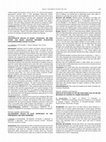Papers by natalia schwarzkopf

Sleep Medicine, 2017
without oxygen desaturations (min O 2 94.7% ± 6.1). Patients had frequent spontaneous arousals (2... more without oxygen desaturations (min O 2 94.7% ± 6.1). Patients had frequent spontaneous arousals (26.2 ± 35.5), prolonged sleep-onset latency (33.5 min ± 28.5) and prolonged wake time after sleep onset (47.0 min ± 36.4). Forty eight percent of patients were diagnosed with postural tachycardia syndrome (POTS) based on tilt table testing, and 50% had a reduced sweat response. Thirty three percent of patients were taking a hypnotic, 26% were taking stimulants, 66% patients an autonomic cardiovascular medication, and 63% of patients were on pain medications. Conclusions: Mild OSA, POTS, and sympathetic cholingergic impairment was common in our hEDS cohort. Polypharmacy was also common, with all patients taking either a hypnotic, stimulant, cardiovascular medication, or pain medication. Patients with hEDS exhibited frequent spontaneous arousals, the etiology of which deserves further investigation.
Behavioural Brain Research, 2015
h i g h l i g h t s • The electroencephalogram of adult rats was recorded during sleep and wakefu... more h i g h l i g h t s • The electroencephalogram of adult rats was recorded during sleep and wakefulness. • The intra and inter-hemispheric coherence of the EEG gamma band was analyzed. • The coherence was larger in W and almost absent during REM sleep.

Behavioural Pharmacology, 2018
Caffeine is a common active adulterant found in illicit drugs of abuse, including coca paste (CP)... more Caffeine is a common active adulterant found in illicit drugs of abuse, including coca paste (CP). CP is a smokable form of cocaine mainly consumed in South America, produced during the cocaine-extraction process. CP has high abuse liability and its chronic consumption induces severe sleep-wake alterations. However, the effect of CP on the sleep-wake cycle and the effect of the presence of caffeine as an adulterant remain unknown. We studied the effect of an acute intraperitoneal injection of 2.5 and 5 mg/kg of a representative CP sample adulterated with caffeine (CP1) on the rat sleep-wake cycle. Compared with saline, administration of CP1 induced an increase in wakefulness and a decrease in light (light sleep) and slow wave sleep that was larger than the effects produced by equivalent doses of cocaine. Compared with CP1, combined treatment with cocaine (5 mg/kg) and caffeine (2.5 mg/kg), a surrogate of CP1, elicited similar effects. In contrast, a nonadulterated CP sample (CP2) produced an effect that was not different from cocaine. Our data indicate that caffeine produces a significant potentiation of the wakefulness-promoting effect of cocaine, suggesting that caffeine should be explored as a causal agent of clinical symptoms observed in CP users. Behavioural
European Journal of Neuroscience, 2017
Recently, a novel type of fast cortical oscillatory activity that occurs between 110 and 160 Hz (... more Recently, a novel type of fast cortical oscillatory activity that occurs between 110 and 160 Hz (high-frequency oscillations (HFO)) was described. HFO are modulated by the theta rhythm in hippocampus and neocortex during active wakefulness and REM sleep. Since theta-HFO coupling increases during REM, a role for HFO in memory consolidation has been proposed. However, global properties like the cortex-wide topographic distribution, and the cortico-cortical coherence remain unknown.

Uploads
Papers by natalia schwarzkopf